You are currently browsing the monthly archive for August 2009.

- Fascinating fishing villages of RIAU
Riau Archipelago was once THE heartland of the Malays of the Malay Archipelago region. Indeed, it was here that the 1st ever book of Malay Grammar , the ‘Bustanul Katibin’ was written & published in 1857. So, it is not surprising to know that this beautiful region is indeed the cradle of Indonesia’s Malay-based national language & culture.

'Silat' - Malay art of self-defense
So with that thought on mind, I decided to take a ‘peek’ at this fascinating clutters of edens. Accompanied by a dear friend from the Philippines, I started my ‘Malay soul-searching’ trip by boarding a boat from Setualang Laut, Johor, Malaysia heading to Batu Ampar Port of Batam. Batam is the nearest island of the Riau Archipelago to Malaysian & Singaporean shores. The one-way boat ride cost RM56 (including Port Tax).
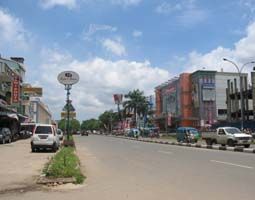
Nagoya Town, BATAM.
From the port, we hopped onto two ‘motorbike taxis’ and headed straight to Nagoya Town. RP5000 for the ride. We then went to look for a room and finally settled with a small, clean room located right in the heart of the town. After few hours of going around town, I then decided that I did’nt really fancy Batam at all! Batam to me is nothing more than a ‘playground’ for Singaporean (and some Malaysian too, I suppose). Of course, due to its strategic proximity to Singapore, Batam has also been designated as a centre of industry and trade for the region. Whatever. Truth was, I couldnt wait to get out of Batam at the soonest possible time and to continue exploring further into the very heart of the Riau Archipelago… and maybe even try to go beyond that.

The main jetty of Tanjung Pinang, BINTAN Island, RIAU.
So, early next morning, we took a cab to Telaga Punggur Port. The cab ride cost us RP30,000. We hopped into a boat and about 1 hour later we were already at the Tanjung Pinang Jetty of Bintan Island. I immediately liked what I saw and knew that we had made a good decision:)

Interesting crowd on main street of Tanjung Pinang town of BINTAN
Tanjung Pinang on Bintan Island is a busy little town. A large section of the old port of this town was built in traditional local style – on stilts, over the water. Nice!
We took our own ‘sweet-time’ and enjoyed the ‘energy’ of the town. We had tea at a nice roadside kiosk and chatted with some locals. They were very friendly and helpful indeed. Well, we even managed to get some ‘tips’ on good accommodation on the island!

eSa & friend @ Tanjung Pinang Corniche. The rest-house where we stayed in was located on top of the hill in the background of this photo. A room with a view... awesome view, indeed!
We decided to stay at an old rest-house located on top of a hill overlooking the sea & part of Tanjung Pinang town.
The view from the room’s balcony was AWESOME! We could clearly see the Penyengat Island and its famous landmark, the bright yellow color building of the Sultan Masjid.
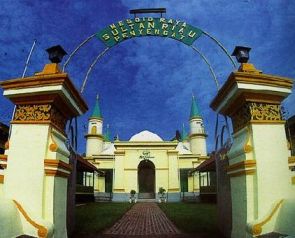
The Sultan masjid of Penyengat Island. Some locals claimed that in the past, the 'masjid' was painted bright yellow by using egg-yolks! Whoa! How much egg-yolks do you think they had to use in order to achieve that effect? Awesome!
The next day, we took a small ‘sampan’ (a small sailing vessel) and sailed across to Penyengat Island. Cost us only RP5,000. The very first thing I noticed when I stepped onto the island: the whole place was sparkling clean! Really! I was impressed:)
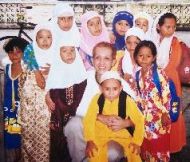
eSa with 'beautiful souls' of Penyengat Island
And then… oh those children! Runing around everywhere with their bright smiles and warm greetings. ‘Assalamualaikum’ (Muslim greeting) was heard over and over again… in every nook & corner that we went.
Well, we were even invited by a middle-aged woman and her children to join them for a feast of grilled fish! They were grilling their fishes when we passed by their house. You bet, we did not even think twice and gladly accepted her generous offer. So, there we were… sitting under a big, shady tree… surrounded by small little ‘angels’… and grilling some fishes while chatting-away happily.
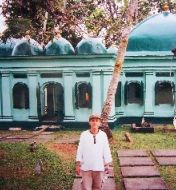
eSa @ 'Green Grave' Complex
Truth to be told, I was actually almost brought to tears when such warmth and friendliness was extended to us… strangers from no where… and being greeted in such manner by the islanders. And this was especially true with the kids of this tiny island. Lovely, beautiful souls of the island. Erm. I sound a bit melancholic and sentimental now, am I not? Well… blame it on RIAU:)
We continued exploring the island and visited some ancient masoleums of significant personalities of the Riau Malay kingdom, ie Engku Puteri and Haji Ali. We also ventured into old palaces of Engku Puteri and Engku Bilik. According to the locals, ‘Penyengat Island’ was actually a ‘wedding gift’ by Sultan Mahmud to his bride Engku Puteri who was the daughter of Raja Ali Haji. Ermmm… how romantic.

One of the many old & abandoned palaces & villas found scattered on the tiny island of Penyengat. This one belonged to Engku Bilik - an inlfuential figure of the by-gone 'Golden-Era' of RIAU Malay Kingdom
Since then, Penyengat Island had become THE centre of government, tradition, Islamic religion and Malay culture. Indeed, Bintan and Penyengat islands have been known among the dwellers of the Malay Archipelago region as the ‘doorstep of history’.
The famous Arab explorer who was known as the ‘Arabian Marco Polo’ – Ibn Battuta – had been claimed to have said “Here there are little islands, from which armed black pirates emerged, possessing armed warships; they plunder people BUT do not enslave them” when referring to the islands of Riau Archipelago.

Stairs leading to an old palace on Penyengat Island
“Tanah air tinggal airnya, Kolong berserakan, Singapura timbul, Singkep tenggelam…”. Loosely translated : ‘ The land (island) is left only with water (and no land/soil on sight), the hollow cavings are scattered all over the place, Singapore risen, while Singkep is sinking…’ . This poetic statement by a blogger named Socrates aptly described the next island that we visited, Singkep Island.

Possibly, the longest jetty in the Malay Archipelago region: Jetty of Singkep Island
Singkep is located at the most end of the Riau Archipelago region. So, I did fulfill a promise to myself of wanting to venture right to the end of the archipelago… and maybe to go even beyond that.
The boat trip to Dabo, Singkep island itself was truly an awesome experience.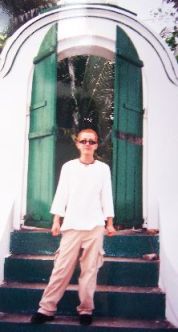 Almost magical, indeed! Almost immediately after the boat left Tanjung Pinang, we were confronted with awesome views of numerous islands, mountain peaks peeking out of the clouds, lonely ‘kelongs’ (fishing huts on pillars) rose from the calm and shallow sea, small huts and houses scattered along the waterside… but most awesomely was the fuzzy contours of Daik Mountain which begun to appear as the boat was approaching the Lingga Island. Immortalised by the Malay in their famous poems of ‘Gunung Daik Bercabang Tiga’ (Daik Mountain with its 3 sharp peaks), the mountain has served as the symbol of strenght and durability for the Malays since aeons ago.
Almost magical, indeed! Almost immediately after the boat left Tanjung Pinang, we were confronted with awesome views of numerous islands, mountain peaks peeking out of the clouds, lonely ‘kelongs’ (fishing huts on pillars) rose from the calm and shallow sea, small huts and houses scattered along the waterside… but most awesomely was the fuzzy contours of Daik Mountain which begun to appear as the boat was approaching the Lingga Island. Immortalised by the Malay in their famous poems of ‘Gunung Daik Bercabang Tiga’ (Daik Mountain with its 3 sharp peaks), the mountain has served as the symbol of strenght and durability for the Malays since aeons ago.
Sadly, though, when we arrived at Singkep Island, we almost immediately realised that this was a very sad place, indeed. When we asked around, one local had even answered us by comparing the present condition of the island to a “negeri dilanggar Garuda” ( a land which is left devastated by the attack of a ‘Garuda’ – a mythical giant bird ).
Indeed. The small Singkep Island was full of holes! Deep, hollow holes. These horrible environmental casualty was the result of hundred of years of tin mining activities. And to make things worst, the sand/soil of this tiny island has also been ‘exploited to the hilt’ in the recent years. Not to mention the abuse of the island’s already- very- limited wealth of the forest. Indeed, if Singkep Island is viewed from above, it may well look like as if the island has been ripped apart… savagely! And by night time (yes…we did spend a night on Singkep Island), as early as 8pm, the whole town was turned into a VERY, VERY quiet and eerie looking place! With its ‘extra dimmed’ street lights (they were ‘extremely’ dimmed, somehow, for some unknown reasons … lack of electric supply maybe?) , the town looked like a backdrop of scenes in horror movies! Really sad. Almost tragic.
Well, after all said and written about Singkep Island, let us not too quick to make any judgement, though. In other words, let us not 100% to… Blame It On RIAU.
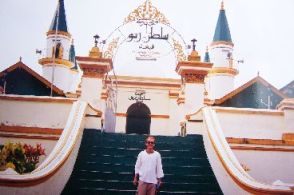
eSa @ Sultan Masjid, Penyengat Island
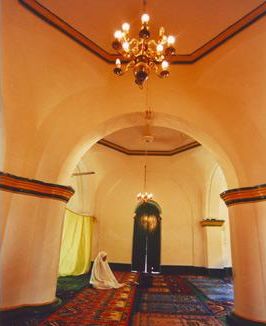
Wishing Malaysians a very MEANINGFUL MERDEKA! And to Muslim readers, ‘RAMADHAN AL MUBARAK!’…
